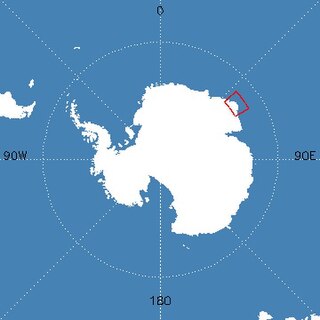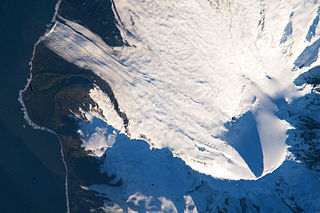Related Research Articles

Lambert Glacier is a major glacier in East Antarctica. At about 50 miles (80 km) wide, over 250 miles (400 km) long, and about 2,500 m deep, it is the world's largest glacier. It drains 8% of the Antarctic ice sheet to the east and south of the Prince Charles Mountains and flows northward to the Amery Ice Shelf. It flows in part of Lambert Graben and exits the continent at Prydz Bay.
Beaver Glacier is a glacier about 15 miles (24 km) long and 4 miles (6 km) wide, flowing west into Amundsen Bay between Auster Glacier and Mount Gleadell. The head of Beaver Glacier is located very close to the base of Mount King in Enderby Land. It was visited by an Australian National Antarctic Research Expeditions (ANARE) party on October 28, 1956, and named after the Beaver aircraft used by ANARE in coastal exploration.
The Scott Mountains are a large number of isolated peaks lying south of Amundsen Bay in Enderby Land of East Antarctica, Antarctica. Discovered on 13 January 1930 by the British Australian New Zealand Antarctic Research Expedition (BANZARE) under Sir Douglas Mawson. He named the feature Scott Range after Captain Robert Falcon Scott, Royal Navy. The term mountains is considered more appropriate because of the isolation of its individual features.

HMAS Labuan (L3501) was a Mark III Tank Landing Ship that served in the Royal Navy during World War II, and with the Royal Australian Navy (RAN) from 1946 until 1951.
Athos Range is the northernmost range in the Prince Charles Mountains of Mac. Robertson Land, Antarctica. The range consists of many individual mountains and nunataks that trend east–west for 40 miles (64 km) along the north side of Scylla Glacier.
Auster Glacier is a glacier about 2 miles (3 km) wide, flowing northwest into the southeast extremity of Amundsen Bay. It was sighted in October 1956 by an Australian National Antarctic Research Expeditions (ANARE) party led by P.W. Crohn, and named after the Auster aircraft used by ANARE in coastal exploration.

Mount Elkins, also known as Jökelen is a dark, steep-sided mountain with three major peaks, the highest 2,300 meters (7,500 ft) above sea level, in the Napier Mountains of Enderby Land. Enderby Land is part of East Antarctica, and is claimed by Australia as part of the Australian Antarctic Territory. The mountain was named after Terence James Elkins, an ionospheric physicist with the Australian National Antarctic Research Expeditions at Mawson Station in 1960.
Kirkby Glacier is a glacier, 20 miles (30 km) in length. This glacier drains the central Anare Mountains of Antarctica and flows northwest to the sea 3 miles (5 km) from Cape North, and just north of Arthurson Bluff, northern Victoria Land. Richardson Bluff rises from its east side.
The Porthos Range is the second range south in the Prince Charles Mountains of Antarctica, extending for about 30 miles in an east-to-west direction between Scylla Glacier and Charybdis Glacier. First visited in December 1956 by the Australian National Antarctic Research Expeditions (ANARE) southern party under W.G. Bewsher (1956-57) and named after Porthos, a character in Alexandre Dumas, père's novel The Three Musketeers, the most popular book read on the southern journey.
Mount King is a large, smooth-crested mountain in the eastern extremity of the Tula Mountains. Part of the Australian Antarctic Gazetteer and the SCAR Composite Gazetteer of Antarctica, it is located in Enderby Land, East Antarctica, which is claimed by Australia as part of the Australian Antarctic Territory. The head of Beaver Glacier is located very close to the base of Mount King.
Wilma Glacier is the western of two glaciers entering the southern part of Edward VIII Ice Shelf in Kemp Land, East Antarctica. The second, eastern glacier is Robert Glacier.

Lied Glacier is a glacier close north of Cape Arkona on the southwest side of Heard Island in the southern Indian Ocean. To the southeast of Lied Glacier is Gotley Glacier, whose terminus is located between Cape Arkona and Cape Labuan. Cape Arkona separates Lied Glacier from Gotley Glacier. To the north of Lied Glacier is Abbotsmith Glacier.

Armstrong Peak is a peak, 1,470 metres (4,820 ft) high, standing 15 nautical miles (28 km) southeast of Mount Codrington in Enderby Land of East Antarctica.
The Aramis Range is the third range south in the Prince Charles Mountains, situated 11 miles southeast of the Porthos Range and extending for about 30 miles in a southwest–northeast direction. First visited in January 1957 by Australian National Antarctic Research Expeditions (ANARE) southern party led by W.G. Bewsher, who named it for a character in Alexandre Dumas' novel The Three Musketeers, the most popular book read on the southern journey.
Mount Storer is a jagged peak in the Tula Mountains, 4 nautical miles (7 km) east-northeast of Mount Harvey. It was sighted from Observation Island in October 1956 by an ANARE party led by P.W. Crohn. It was named by the Antarctic Names Committee of Australia (ANCA) for William Storer, a radio operator at Mawson Station in 1954.
Palmer Point is a rock point on the coast of Antarctica, about 2 nautical miles (3.7 km) west of Strover Peak and 8 nautical miles (15 km) west-northwest of Mount Caroline Mikkelsen. Photographed by U.S. Navy Operation Highjump, 1946–47. Visited by I.R. McLeod, geologist with the ANARE Prince Charles Mountains survey party, 1969. Named by Antarctic Names Committee of Australia (ANCA) for J. Palmer, helicopter pilot with ANARE in 1968.
Hays Glacier is a glacier flowing north into the head of Spooner Bay, Enderby Land, Antarctica. It was plotted from air photos taken by the Australian National Antarctic Research Expeditions (ANARE) in 1956, and was named for J. Hays, a United States observer with the ANARE which made a landing nearby.
Mount Macklin is a mainly snow-covered ridge with an exposed summit at 2,005 metres (6,580 ft) just east of Mount Shaw in the Anare Nunataks of Mac. Robertson Land, Antarctica. It was first visited in November 1955 by an Australian National Antarctic Research Expeditions party led by J.M. Béchervaise, and was named by the Antarctic Names Committee of Australia for Eric Macklin, a radio operator at Mawson Station in 1955.
Tester Nunatak is the southernmost of a group of three nunataks in the northern part of the Manning Nunataks, in the east part of Amery Ice Shelf. The nunataks were photographed by U.S. Navy Operation Highjump (1946–47) and ANARE (1957). They were visited by the Soviet Antarctic Expedition in 1965 and by ANARE in 1969. Named by Antarctic Names Committee of Australia (ANCA) for J. Tester, aircraft engineer with the ANARE Prince Charles Mountains survey party in 1969.
Kenneth Ridge is the northernmost of three rock outcrops in the northern part of the Manning Nunataks, Antarctica. The nunataks were photographed by U.S. Navy Operation Highjump (1946–47) and Australian National Antarctic Research Expeditions (ANARE) (1957). They were visited by the Soviet Antarctic Expedition in 1965 and by ANARE in 1969, and were named by the Antarctic Names Committee of Australia for Kenneth A. Smith, a radio officer at Mawson Station in 1969, and a member of the ANARE Prince Charles Mountains survey party in the same year.